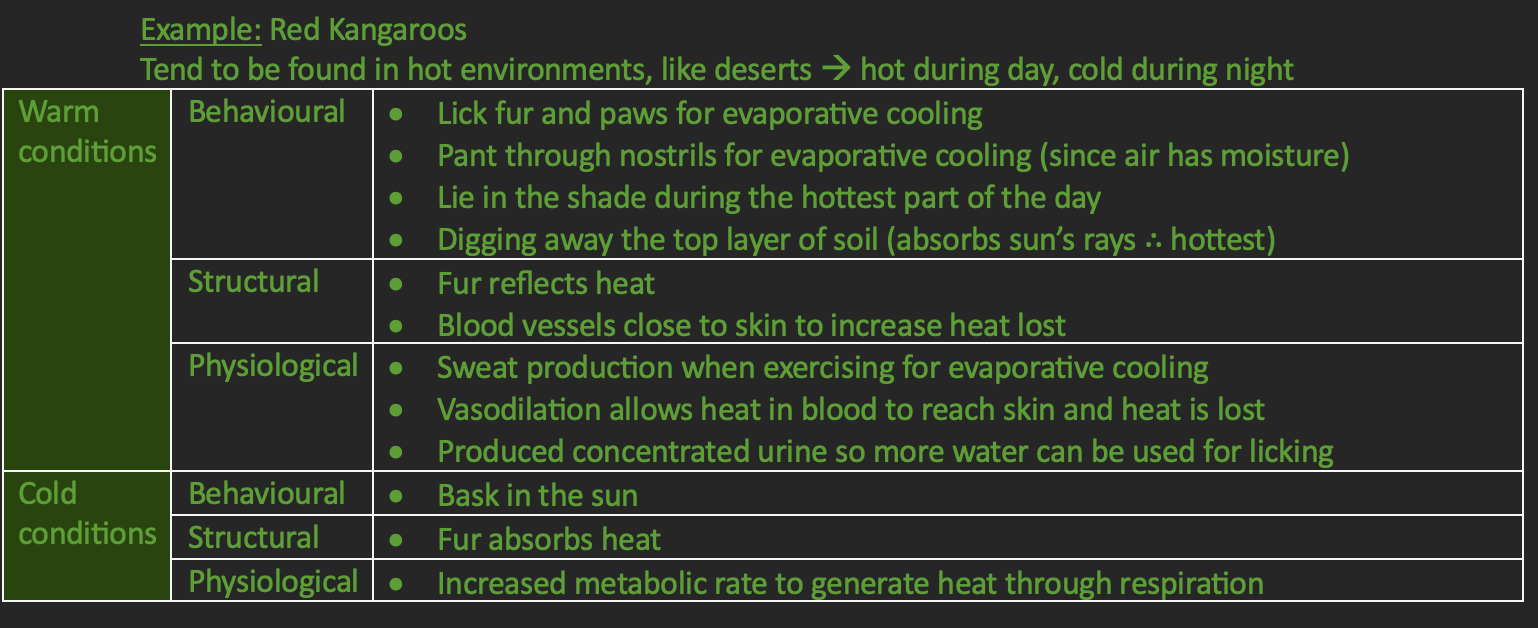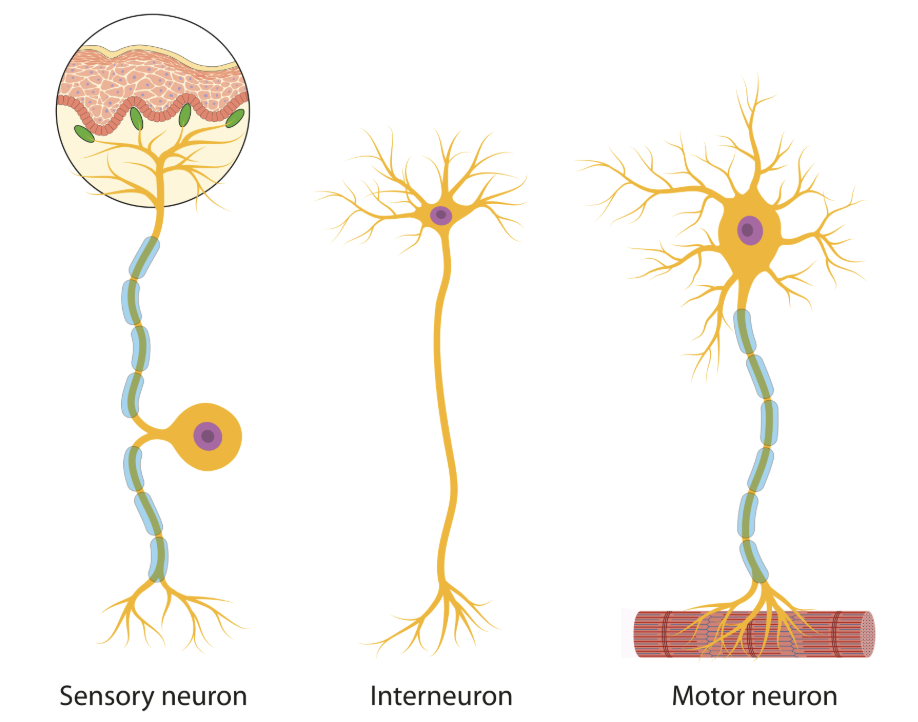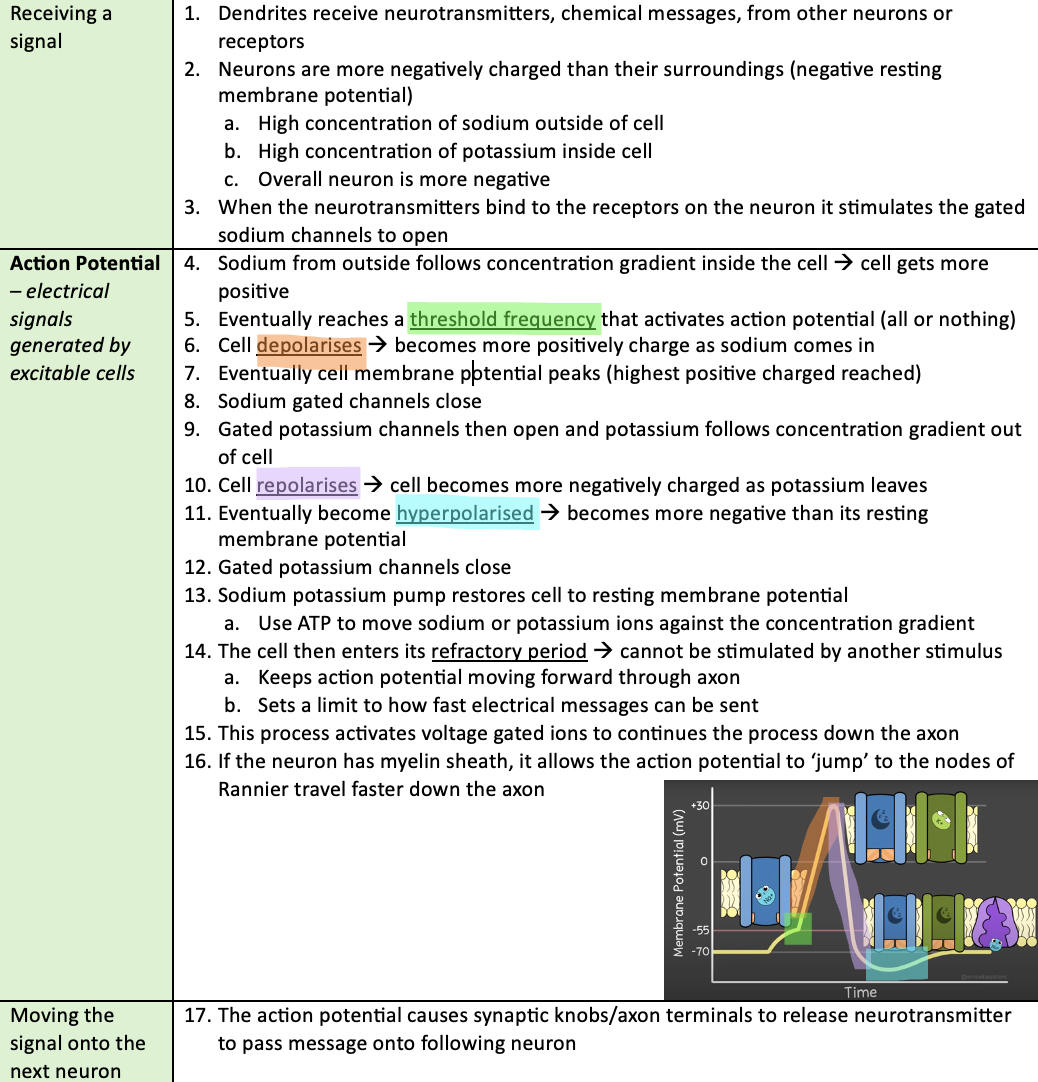Homeostasis
1/30
There's no tags or description
Looks like no tags are added yet.
Name | Mastery | Learn | Test | Matching | Spaced |
|---|
No study sessions yet.
31 Terms
Homeostasis Definition
Regulation definition
Homeostasis - The process by which the body maintains a constant internal environment
Regulation – responding to fluctuations around a set point
In animals: use nerves, hormones and hypothalamus
In plants: achieved through hormones
Importance of homeostasis
Required to keep our cells and enzymes functioning
Many reactions inside the body only work in certain conditions, regardless of a changing outside environment
Each variable in the body needs to be kept within a tolerance limit for the body to function
Tolerance limit – range of acceptable deviation
Inside tolerance limits = reactions proceed normally
Outside tolerance limits = reactions are impaired = negative consequences on health of organism
E.g. optimal digestion in the stomach occurs at a pH of 2. Any higher pH = enzymes cannot break down food as efficiently
e.g. of homeostasis
• Blood pH levels
• Blood glucose
• Internal body temperature
• Water availability
The Stimulus and Response Model
The body’s way of detecting an internal / external change in the environment and react accordingly
Stimulus - Something happens that causes a change in the environment
Receptor - Recognises and respond to stimulus, by sending a message the CNS
Thermoreceptors – detect changes in temperature
Chemoreceptors – detect the presence of particular chemicals
Mechanoreceptors
Photoreceptors – light receptors
Nociceptors – pain receptors
Control Centre - Information from sensory receptors is compared to expected levels
Normally the central nervous system (CNS) in animals Brain and spinal cord
Figures out how to respond appropriately and then sends a message to the effector
Effector - Enacts homeostatic response → Fixes the imbalance
Muscles (expand or contract) → Nervous system - Electrical impulse sent along nerve cells
Glands (release secretion) → Endocrine system - Uses hormones to act as chemical messengers sent through the blond
Response - Action body takes to restore balance
Scale of the response depends on
Sensitivity of receptor
Tolerance of CNS
Efficiency of effector
Feedback loops
Positive | Negative |
When a variable triggers an amplifying response
| When a variable triggers a counteractive response
|
e.g. Pregnancy In the late stages of pregnancy, when the baby’s head touches the cervix, it dilates, which causes oxytocin to be released to further the dilation occurring. This happens in a cycle to push the baby out. | e.g. Thermoregulation temp increases → thermoreceptors → hypothalamus → muscular skeletal system, blood vessels →metabolism decrease, sweat, vascodilation → temp goes down e.g. Glucose levels in blood levels rise → sensor cells in pancreas → pancreas beta cells → liver, muscle and fat cells take in mroe glucose, muscle/liver converts it to glycogen |
Thermoregulation
internal regulation of an animal’s body temperature
Body temperature – most optimal temperature for reaction in organism to occur
37 in humans
ensures all chemical reactions occur at the optimal temperature → highest rate of reaction → body works the most efficiently
Endo vs Ectotherms
Endotherms | Ectotherms |
Warm-blooded
| Cold-blooded
|
e.g. Dogs, elephants, humans | e.g. Lizards |
Process of thermoregulation
stimulus | increase / decrease in body temp |
receptor | Thermoreceptors in skin
Thermoreceptors in the hypothalamus
|
control centre | Nervous system: Receptors send messages to the hypothalamus
Endocrine System: Thyroid stimulating hormone (TSH)
|
effector | Muscles, blood vessels, cells |
response | Responding to Decrease in Temp
Responding to increase in temp
|
Glucose Homeostasis
stability in the levels of glucose in the blood (BGLs)
Levels rise after eating dinner
Fall after having done exercise or not eating for a while
If it moves out of the tolerance limit, a homeostatic response is triggered
3.5-8 millimole per litre (mmol/L)
Excess glucose is stored as glycogen (polysaccharide form can be broken back down into glucose monosaccharide)
Glycogen is stored inside of liver and skeletal muscle cells
Importune of glucose / glucose homeostasis
When food gets broken down it releases glucose
Glucose is absorbed by small intestines and released into bloodstream
It is dispersed through body and taken up by cells
Used in respiration to make ATP for energy
Powers cellular functions (e.g. DNA replication, protein synthesis, etc…)
Keeps body’s tissues working properly
Process of glucose regulation
Stimulus | Blood glucose levels fall below the tolerance limit | Blood glucose levels rise above the tolerance limit |
receptor | Sensor cells in pancreas sense BGLs dropping below 5 mmol/L | Sensor cells in pancreas sense spike in BGLs above tolerance limit |
control centre | Endocrine system: Alpha cells in Pancreas
+ adrenal gland produces cortisol → proteins break down into glucose → ensures enough glucose in blood for fight/flight response | Endocrine system: Beta cells in Pancreas
|
effector | Target tissues are the liver and skeletal muscle cells | Target tissues are fat, liver and skeletal muscle cells |
response |
|
|
Endotherms → behavioural, structural and physiological adaptations in endotherms that assist in maintaining homeostasis
Adaptations – characteristic that increases an organism’s chance of survival and reproduction in its environment
Caused by natural selection → NOT chosen by organism, but rather a produce of mutations and selection pressures
Behavioural = way the organism acts
Structural = physical characteristics
Physiological = the way the body functions

The Nervous System role
a system that allows organisms to take in and respond to information from the environment by passing electro-chemical messages through a network of neural pathways
Takes messages from receptors and interprets the correct response to the information
Sends messages to effectors to respond to the stimulus
Messages are carried as nerve impulses along neurons (nerve cells)
Structure of neurons and their function
Neurons – functional units of the nervous system that carry signals around the body
General structure | B DAMS 1. Dendrites – receive the neurotransmitter (signal containing information) from other neurons → Large surface area = increase information received 2. Cell Body - interpret the neurotransmitter and if it is strong enough, it is sent sends to the axon → Contains the nucleus 3. Axon – carries the signal (called an action potential at this stage) to the synaptic knobs 4. Myelin sheath – insulates the axons 5. Synaptic knobs – release the action potential as a neurotransmitter to be received by other cells → Connects neuron to the next cell |

types of neurons

Components of the nervous system
CNS
brain
spinal cord
PNS → neurons
somatic nervous system
autonomiuc NS
sypathetic and parasympathetic
central nervous system
Includes the brain and spinal cord
Gather information from the body and coordinates responses
Brain - serves as the primary processing centre
Forebrain
Cerebrum - memory, and voluntary movement
Thalamus – receives sensory information from body
Hypothalamus - regulates body temperature, hunger, emotions, hormones release from pituitary gland
Mid brain - controls reflex movements of eye muscle, head and neck
Hindbrain
Cerebellum - controls and coordinates muscular activity
Medulla oblongata - controls involuntary actions
Spine - Sends motor commands from the brain to the peripheral body and relay sensory information from the sensory organs to the brain
Peripheral nervous system
Neurons that connect the CNS to the rest of the body
Path that carries messages towards and away from CNS
Somatic Nervous System
The voluntary, conscious part of the nervous system
Nerves connected to skin, sensory organs, skeletal muscles
Processes information that arrives from external stimuli (five senses)
Controls skeletal muscles to allow for voluntary movement
Autonomic Nervous System
The involuntary, unconscious part of the nervous system
Nerves connected to cardiac muscle, smooth muscle in organs
Controls heart rate, digestion, salivation, sweating, pupil diameter, etc…
Involves parasympathetic and sympathetic nervous system
parasympathetic (rest and digest) | sympathetic (fight or flight) |
Stimuli:
Control centre:
Effectors and Responses
| Stimuli:
Control centre:
Effectors and Responses
|
The Endocrine System overview
a group of glands that secrete hormones
Glands – a group of specialised, hormone-secreting cells
Hormone – chemical messengers that cause a response in another region of the body
e.g. insulin is a hormone that acts on liver, muscles and fat cells to maintain glucose levels
Different hormones are produced by different glands
Each hormone binds to specific receptors found on target cells
Target tissues – tissues that contain target cells, intended destination of hormone
Hormones can have effects on tissue widely distributed throughout the body
A tissue just needs a hormone receptor to enact a response
Transported in the circulatory and lymphatic systems
Hormones are diffused out of glands into blood to be takes around by circulatory system
Blood is pumped through blood vessels
Relay messages from the receptor to the control centre to the effector, and used by the effector to make a response
how endocrine system works
Regulated by the stimulus-response model releases hormones in response to certain stimuli
Stimuli cause endocrine glands to make and release hormones
Neural stimuli – receiving nerve impulses
Hormonal stimuli – detecting change in the concentration of hormone
Humoral stimuli - detecting change in the concentration of a substance in the blood
Once hormone is released, it binds to its target cell to ensure a response
If the cell has more receptors = more dramatic response
Endocrine Glands and Hormones
Endocrine Gland | Hormone |
Hypothalamus (brain) |
|
Pituitary gland (brain) | Posterior pituitary gland • Stores and secretes ADH Anterior pituitary gland • Producers of TSH, growth hormone, FSH, LH |
Pineal gland (brain) | melatonin for sleep |
Thyroid gland (neck) | T3 and T4 involved in thermoregulation by increasing metabolism |
Thymus gland | thymosin to stimulate the development of T cells |
Pancreas (behind stomach) | glucagon and insulin |
Adrenal glands | aldosterone, adrenaline and noradrenaline → Controls blood pressure and fight or flight response |
Gonad glands | ovaries → oestrogen and testosterone testes → testosterone |
Endocrine vs Nervous system

thermoregulation vs glucose regulation

Osmoregulation in plants definition
internal regulation of a plant’s water and salt levels
Maintains salt and water concentration → since salt controls osmosis and moves water
Plants need water to be turgid (full vacuole) helps them stand up straight
Water dissolves minerals and allows them to be transported around the plant
Water needed for photosynthesis
osmoregulation: dry environments
Mesophytes: plants adapted to live in moderately wet environments (e.g. corn, roses)
close the stomata (pores on the underside of the leaf that faciliate gas exchange) by decreasing the amount of water in guard cells
Controlled by abscisic acid (hormone)
Generally, close their stomata when it is hottest (e.g. midday) and leave them open at other times
Allows leaf to maximise photosynthesis and minimise water loss
Waxy Cuticle → A waterproof barrier that reduces water loss
Vacuoles → store water + keep plant cell turgid (stand up)
Xerophytes: Plants that are specifically adapted to live in arid regions (e.g. cactus, eucalyptus tree)
Reduced number of stomata in leaves → Less stomata = less water vapour lost from transpiration
Drooping leaves, Sunken stomata, Hair on leaves
Traps air around the stomata
Air becomes saturated with water vapour
Creates a humid microclimate
Means less water is transpired
osmoregulation: wet environments
Hydrophytes: plants adapted to wet environments (e.g. waterlily)
Increased number of stomata
More stomata = optimised gas exchange = more transpiration
Large and flat leaves
Large surface area to volume ratio
Further promotes water loss (more area for transpiration to occur)
osmoregulation: salty environments
Halophytes: plants that can survive in saline environments
Due to osmosis – the movement of water from high to low water concentration across a semipermeable membrane
Water will move from less salty to salty environments to maintain balance
For plants submerged in salt water (e.g. mangroves)
Water within roots (needed by plant) is more likely to move of the plant into the soil
Makes it harder for the plant to absorb water from the soil
Excess salt concentration can be toxic
Salt exclusion
Special tissues in the roots stop salt from entering the plant but allow for water uptake
e.g. grey and red mangroves
Salt excretion
Plant actively concentrates salt and excretes it through special glands on leaves
Salt is crystalised on surface to be washed or blown away
e.g. grey and river mangroves
Salt accumulation
Plant deposits salt in older tissue (e.g. old leaves)
These tissues are shed to remove salt
e.g. milky mangrove
Define action potential
Action Potential – electrical signals generated by excitable cells
Can be sent to neighbouring cells
Excitable cells – generates electrical signals from a stimulus (e.g. neurons, muscle cells)
define membrane potential
Membrane potential – difference between electrical potential inside and outside the cell
• You compare charge inside and outside of cell
• Negative charge/voltage = polarised
• Positive charge/voltage = depolarised
Types of neurons
Sensory neurons | Carry electrical impulses from receptors to the CNS
|
Motor neurons | Carry electrical impulses from the CNS to effectors
|
Interneurons / relay neurons | Transmit electrical impulses between neurons
|
describe how neural pathways work
Neural Pathways - connections between neurons that allow signals to travel from one area to another
